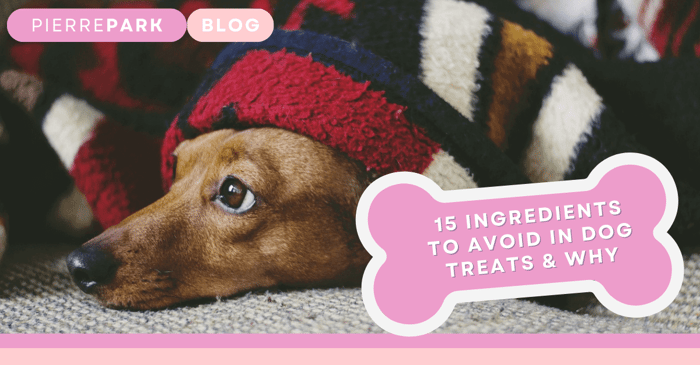Table of Contents
Vet-Approved

This article has been rigorously reviewed and validated by Dr. Annina Müller, med. vet., an accomplished veterinarian who earned her veterinary degree at the University of Bern, specializing in Small Animal Surgery. Her expertise ensures that the advice provided is both current and accurate in the field of veterinary medicine.
Most dog owners love to feed their pups treats, and here at PierrePark, we're no different, but have you ever looked at the ingredient list on the treats you feed your dog?
Most dog treats in stores and online contain long lists of preservatives and added ingredients that provide little to no value to your dog's health, so we've crafted this article to take you through 15 ingredients you should avoid in dog treats and the reasons why for each one.
Let's get straight into it.
1. Xylitol
Xylitol is a natural sugar alcohol commonly used as a sugar substitute in many human foods, including peanut butter. However, it's crucial to be aware that xylitol is highly toxic to dogs. Even small amounts found in peanut butter can lead to seizures, liver failure, and even death. Sometimes, it's labeled as birch sugar on food labels, so always check for this ingredient and avoid it, especially when making homemade dog treats.
2. BHT
BHT, or Butylated Hydroxytoluene, is a lab-made chemical used as a preservative similar to BHA.
For humans, BHT is often used as a medicine to treat genital herpes and AIDS, as well as a preservative in food.
Similar to BHA, BHT has also been linked to several health issues, including a study that found BHT promoted thyroid carcinogenesis in rats as well as the induction of urinary bladder tumors.
3. Ethoxyquin
Ethoxyquin is another preservative found in several dog treats and used to preserve fats specifically.
Ethoxyquin was authorized in the EU until 2017 when the EFSA (European Food Safety Authority) found that they could not rule out the risk to animals with a long life expectancy due to an impurity called p-phenetidine.
Despite this, It is still permitted as an animal feed additive in the US.
4. BHA
BHA, or Butylated Hydroxyanisole, is a waxy, solid petrochemical that has been used as a preservative in foods and other products for many years. This is thanks to its ability to prevent oxidization of the oils found within food.
BHA is found in many dog treat products and is used to preserve the food so that it lasts longer; however, there are many arguments against using this preservative.
Firstly, BHA has been banned for human consumption in many countries, including Japan, Canada, and Europe, although it is still recognized as generally safe by the US FDA.
It is permitted in pet food in small amounts in Europe and the US, however.
The IARC (International Agency for Research on Cancer) found that BHA had sufficient evidence of carcinogenicity in experiment animals in 1987. Other associated risks include the European Union considering BHA as a hormone disruptor.
5. Food Dyes
While many food dyes are technically deemed safe for pet consumption and are FDA-approved, it's important to note that these additives offer no nutritional benefit for your furry friend. Moreover, numerous food colorings have been associated with health concerns in humans.
For instance, consider Yellow 5, which in Europe requires a label warning about potential hyperactivity. Additionally, dyes like Red 40 are notorious for their side effects, particularly in children. When it comes to your beloved canine companion, it's worth considering whether these additives are necessary or potentially harmful.
6. Corn Syrup
Corn Syrup is made from the starch of corn and is added to foods for several functions.
For dog treats, corn syrup is added to enhance flavor and texture, although it should be avoided as it contains a lot of sugar, which is not nutritionally beneficial for your dog.
Vets may sometimes recommend corn syrup if your dog experiences low blood sugar, but that is the only use case when it should be fed.
7. Low-Quality Rendered Fats
Fat sources are not a bad thing to have on the ingredient list of a dog treat as long as the source of fat is specified.
Rendered fats or fats from rendered sources tend to be lower-quality fats obtained from generic by-products, diseased farm animals, or even road kill.
When reviewing the ingredients in dog treats, make sure to check for a clearly identified fat source, like chicken or salmon fat. If a treat doesn't specify the fat source, there's a good chance it's of lower quality.

If you want to avoid these harmful chemicals entirely, consider our sweet potato single ingredient dog treats. Your dog will absolutely love them!
8. Melamine
Melamine is an industrial chemical not approved for human or dog use in the US; however, in 2007, there was a recall of over 150 pet brand foods due to the potential presence of Melamine in their food.
Research is still underway to figure out why Melamine is so dangerous; however, it is thought to be even more hazardous in combination with cyanuric acid due to the production of crystals in urine and kidney tissue.
The Melamine was traced to products labeled as wheat gluten or rice protein concentrate imported from China.
9. White Flour
Flours of various types are found in many dog treats and DIY dog treat recipes, but white flour should be avoided.
This is mainly due to the lack of nutritional value of white flour and the sheer amount of processing involved with its production.
10. Propylene Glycol
Propylene glycol, a synthetic additive used to retain moisture, might be familiar to you as a significant component in antifreeze products. While it's considered generally safe for human consumption by both US and European food authorities, it's important to exercise caution when it comes to your canine companion.
Although it's present in several dog treats and generally safe in small amounts, it's concerning to note that the FDA has banned its use in cat food due to its association with Heinz body formation. While dogs are less affected by it, being aware of this difference is crucial to ensure your dog's well-being.
11. Low-Quality Meat Meals
Meat meal is essentially a term used for meat that has been cooked down to create a highly concentrated protein powder, similar to rendered fat.
Whether meat meal is a healthy choice for your dog depends on the quality of the meat that was used in its production. Some meat meals can be a nutritious source of protein for your pup, but this depends on the quality of the meat that was rendered.
Unfortunately, many pet food products use lower-quality meat sources in their meat meals. You can often identify these lower-quality products because they don't specify the type of meat source.
Watch out for generic terms such as Animal Meal, Chicken by-product Meal, and Meat And Bone Meal. These terms typically indicate low-quality protein sources derived from slaughterhouse waste or even diseased cattle. These meals may even contain indigestible parts like cartilage or feathers. Therefore, it's advisable to avoid meat meals unless the source is clearly stated for the well-being of your dog.
12. Bone Meal
Bone meal consists of ground-up animal bones, and when sourced from high-quality materials, it can offer some benefits to your dog when consumed in moderation.
Nevertheless, it's essential to be aware of the potential risks associated with bone meal, especially when ingested in large quantities. Large bone fragments may not be easily digestible and can lead to gastrointestinal blockages, offering little to no nutritional value.
It's worth noting that the nutritional advantages of bone meal, such as its high calcium and phosphorus content, can often be obtained from other ingredients without the potential hazards it carries.
13. MSG
MSG, a flavor-enhancing salt added to certain dog treats, is considered safe in small quantities according to the US Food and Drug Administration.
However, it's essential to be aware that studies investigating MSG for animal consumption typically involve much larger amounts than what's typically found in dog treats. This research has suggested potential links to neurotoxicity, obesity, and diabetes.
In small quantities, MSG is unlikely to pose significant problems for your dog. Nevertheless, the presence of flavor enhancers raises questions about why they are needed if high-quality protein sources are being used in the treats.
14. Nitrates
Sodium nitrate is a commonly used preservative in dog treats, but it's important to be aware of its potential risks. It has been linked to poisoning incidents in dogs and cats, particularly when they consume dog food with high levels of sodium nitrite.
Although dogs can tolerate small amounts of sodium nitrate, it's advisable to err on the side of caution and avoid it altogether. This way, you can ensure that your dog enjoys the highest quality treats without any potential health concerns.
15. Sodium Hexametaphosphate
Sodium Hexametaphosphate is a common ingredient in dental dog treats, known for its ability to reduce calculus formation.
While this ingredient is generally safe for dogs when used in small amounts, it's worth considering an alternative approach to maintaining your dog's dental health. Cleaning your dog's teeth using a dog toothbrush and dog toothpaste is a more effective method and eliminates the potential risk of introducing additional chemicals into your dog's diet.
What Ingredients Should You Look For In Dog Treats?
When selecting a dog treat for your pup, it's best to look for treats that contain as few ingredients as possible and to ensure that the ingredients used are high quality and not highly processed.
The protein source listed needs to contain information about its origin, and flavor enhancers, preservatives, and additives should be avoided as these can lead to problems if fed daily in moderate sizes.
Summary
FDA-approved ingredients are not likely to cause significant issues in small quantities. Still, we're firm believers in offering dog treats that contain as few ingredients as possible that are of the highest quality, so you know exactly what your dog is eating.
After all, if there are alternatives that don't contain a long list of relatively unknown chemicals, why bother feeding them to your dog?
Our healthy dog treats are the ideal choice because they only contain sweet potato, a high quality and nutritious snack for your pup that is low in calories and contains no harmful chemicals.






